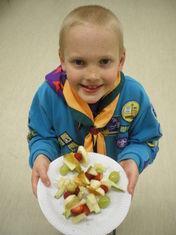
Beaver Scouts across the UK are choosing fruit and vegetables over crisps and cakes, thanks to the launch of the new Eat in Colour (EiC) Healthy Eating badge.
So far, nearly 20,000 Healthy Eating activity packs have been requested by Beaver leaders for the youngsters in their groups.
With childhood obesity on the rise, EiC has teamed up with the Scout Association to combat the issue head-on with the sponsorship of the badge, which was launched in February.
The EiC Healthy Eating badge aims to teach kids practical and fun ways to enjoy a balanced diet incorporating plenty of fruits and vegetables. Every Beaver who goes for the badge will learn skills such as how to make fruit salads, healthy snacks and delicious sandwiches packed with healthy fillings, and will learn which foods should be enjoyed in moderation.
EiC, the industry's generic promotional campaign, will also give advice to Beavers on how to help out at home, such as preparing simple things for tea or helping with the weekly shop.
EiC chairman Anthony Levy said: “The EiC Healthy Eating badge gives us a chance to make a real difference to children across the UK. A lot of these kids don’t learn about a balanced diet until it’s too late, and they have developed bad eating habits. By targeting six- and seven-year-old Beavers, we truly can change lives.”
A Scouts Association spokesperson added: “A balanced diet - along with exercise and enjoying the great outdoors - is an important part of any child’s healthy development. We are pleased, therefore, to welcome EiC’s sponsorship of the Beavers’ Healthy Eating badge, which will leave Beavers in good stead to enjoy a healthy diet for life.”
According to statistics taken from the Information Centre Report 2006, among boys and girls aged two to 15, the proportion that were obese increased from 10.9 per cent in 1995 to 18 per cent in 2005 among boys, and from 12 per cent to 18.1 per cent among girls. For those aged two to 10, the increase over the same period was from 9.6 per cent to 16.6 per cent for boys, and 10.3 per cent to 16.7 per cent for girls.






No comments yet